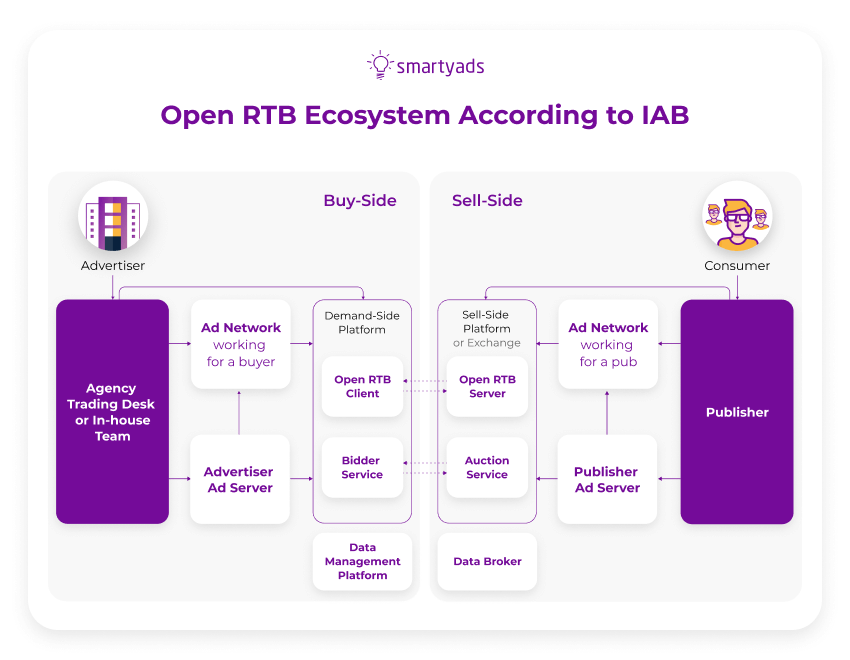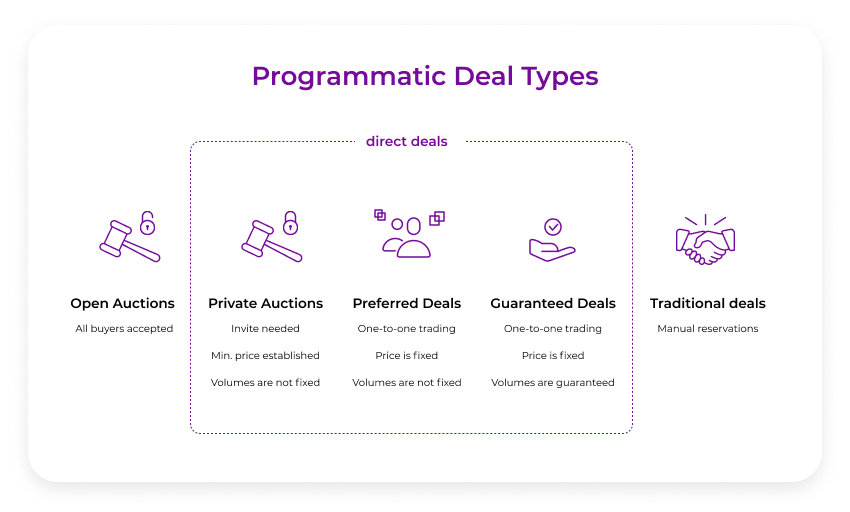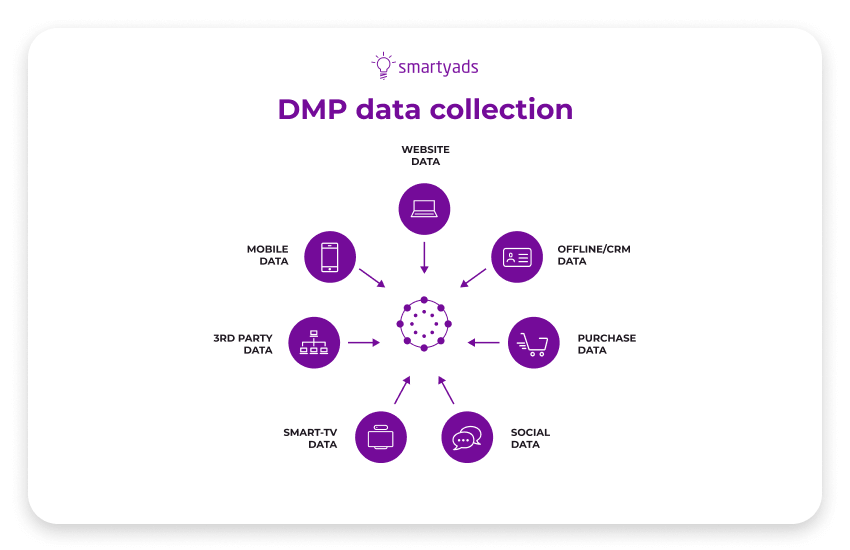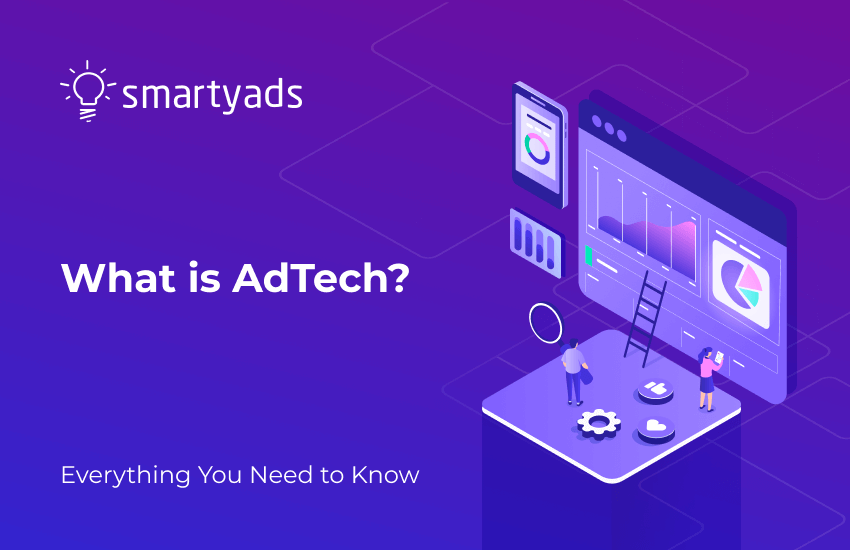Today’s ad tech industry is a lot more different from what it was a dozen and even a couple of years ago. While for 20th-century marketers it was enough to make an arrangement between an advertiser and a publisher, nowadays the situation has changed and the way businesses interact with customers is drastically different. The most significant change occurred at the dawn of digital advertising evolution when the first advertising technology was introduced. Every year numerous ad tech solutions emerge and marketers refine their strategies, adding up more and more sophisticated tools.
So what is ad tech industry? How does ad tech work? Nowadays one can hardly find any ad on the internet which wouldn’t be dependent on the ad tech software at least to some extent. This isn’t surprising with 74% of marketers choosing to work with agencies whose area of expertise allows them to leverage the full potential of advertising technology.
So, what is ad tech?
Ad tech (also sometimes spelled as adtech) is an umbrella term that stands for advertising technology. Ad tech includes all kinds of tools and software platforms that advertisers utilize to deliver their ads to potential customers. Publishers use advertising technology platforms to automate their inventory monetization with ads. Ad tech helps businesses plan and execute marketing strategies, from three stages of media-buying and selling to performing analysis and optimizing their advertising efforts. Ad tech software is at the core of the programmatic advertising industry. It facilitates targeted advertising, as well as omnichannel marketing strategies and many other advanced promotion techniques.
Both supply and demand sides significantly benefit from advertising technology, so media-traders need to know at least the basics of it to leverage its strong points.
Why do we need ad tech?
To answer this question let us dive a little bit into the past and remind how advertising was done before the ad tech industry was introduced and the programmatic ecosystem emerged. With the traditional ad placement approach, advertising messages were delivered to the viewers via as many different channels and spaces as possible. Such a strategy is not bad. Moreover, it can even be effective for some goals, like increasing brand awareness and getting exposure for the new businesses and products. However, such distribution of resources is far from perfect and will hardly give advertisers any sound results - ads broadcasted to the mass audiences tend to be less relevant to each specific viewer. They are hard to personalize which makes it almost impossible to build a real connection with the customer. As a result - lower ad performance and a huge waste of time and effort.
Luckily, with adtech, modern advertisements are delivered to the most relevant audiences with the perfect timing and within the most suitable context. With their help marketers save a significant portion of their resources and efforts, while publishers get the opportunity to monetize their digital assets and the users receive the most helpful and relevant offers.
Instead of placing ads in a random manner hoping for luck, advertisers can integrate sophisticated software, extensive data, and cutting-edge strategies into perfect campaigns that deliver their messages to the right users. All this is possible thanks to these revolutionizing marketing techniques brought by the ad tech industry:
Programmatic advertising is executed with advertising technology that automates the media trading process between advertisers and publishers. It allows the demand-side to bid on the most relevant ad placements. When it comes to the supply-side, with the help of ad tech, space on the publishers’ digital assets can be sold for the best price within a matter of seconds. Thus, programmatic advertising has redefined the way marketers communicate with their customers.
Targeted advertising - is an approach to advertising that includes buying target audience segments according to the campaign criteria: demographics, location, channel, and so on. This way brands’ messages are delivered to certain demographics or people with specific interests and the advertisement’s relevance is ensured for the user. Serving helpful content at the right time and place is a great way to reduce wasteful spending, so targeted advertising can often be a key to make your campaigns more cost-efficient.
Omnichannel marketing - is a newly-developed type of marketing strategy that utilizes numerous channels to fuel the interactions between the brand and its potential customers. This type of marketing can help in building a seamless experience for users within both offline and online advertising channels, like store visit, social media (Facebook, Twitter), website, etc. Omnichannel campaigns also wrapped around multiple devices to deliver the message to the user. For instance, a promotional code offered via connected TV ads that is available to download within the mobile app. By using this technique, brands can create an integral vision of their mission and service, thus, building a solid brand image based on versatile customer experience. This way advertising technology allows marketers to get maximum results from carefully planned cross-channel efforts.
There are also a couple of traditional marketing strategies that are significantly enhanced with ad tech software. These strategies include:
- direct response marketing or advertising - a kind of strategy that expects immediate action from the users once they encounter an ad. Such an ad usually includes an offer, information about it, and a call-to-action. The expected result is usually measured immediately.
- performance advertising - the process of ad delivery that includes constant optimization of ad campaigns in accordance with the analysis of their previous performance, as well as further adjustments to the marketing strategies.
All these strategies and solutions are making a significant difference for all of the players within the digital advertising industry. And the specific benefits that ad tech platforms give to the advertisers and publishers will be discussed in the next sections.
How does ad tech work for advertisers and publishers?
The main purpose of any ad tech solution is to help publishers and advertisers perform successful and efficient media trading deals via programmatic algorithms. That’s what technology for advertising is made for. To better understand how exactly various ad tech solutions work for demand and supply sides, let us review the problems of each and discover how ad tech software responds to them.
The demand side usually represented by the advertisers, is in search of the most efficient strategy to reach their target audience for the best possible price. This is usually achieved by running and constantly optimizing personalized programmatic campaigns, ad targeting and retargeting your potential clients. The demand side benefits from ad tech solutions as they make it possible to create a full-funnel marketing strategy based on programmatic software.
The supply side i.e. publishers and the resellers of their inventory seek to generate revenue from their digital assets by running ads on ad placements (and getting measurements on engagement and other user data). To perform all this they need to configure inventory so that it would satisfy the demand side’s requirements. With the help of adtech, publishers can manage inventory monetization and keep track of all the necessary assets, often within a single interface.
Together, the supply and the demand sides meet at the neutral environment of the digital advertising ecosystem supported and facilitated by such ad tech software as an open advertising marketplace. This platform creates ad tech space that is designed to enhance the communication between sides and make media-trading as beneficial as possible for both of them. Adtech is also responsible for many of the operations related to data collection and processing. All this to ensure swift and precise ad delivery to the user who receives a digital ad.

The connection between media buyers and digital media owners is facilitated by many entities, so at the first glance, the system might seem too complicated. It all, however, gets much more clear once we explore these elements of the ad technology landscape one-by-one:
Ad exchange is a platform that matches the supply and the demand side and facilitates the transactions between them. These usually include advertisers and marketers, brands, ad agencies, ad networks, and the DSPs for the demand side, as well as publishers, resellers, and the SSPs for the supply side. With the help of this platform, publishers can ensure their remnant inventory is sold for the best price, while the advertisers can enjoy the possibility to launch highly targeted campaigns.
Ad network is an entity that collects and selects ad inventory and provides advertisers with the opportunity to establish direct communication with publishers. It can also be used to strike other types of deals (for instance, auctions) depending on the sides’ choice.
Agency Trade Desk or ad agency is a company that helps businesses to market their product or service and manage their campaigns. Ad agencies gather insights, match clients with appropriate suppliers, and can even help with handling marketing budgets. The process is somewhat similar to outstaffing ad tech services where a dedicated professional team handles part or all of the brands’ marketing activities.
Content Delivery Network is a platform that hosts ad creatives and helps to ensure a smooth user experience by reducing page load time. This solution is even more important for video advertising, as it involves delivering huge files that can slow down the whole process.
Ad server is an adtech solution that automatically serves ad creative from the Content Delivery Network once the user visits the supplier’s channel. It also can measure the ads’ performance by counting impressions, clicks, conversions, or other metrics.
So, in a nutshell, thanks to adtech today’s advertisers don’t have to reach each inventory supplier and spend tons of time negotiating to strike a deal. On the other hand, publishers get an opportunity to effectively manage and fill in numerous ad placements across platforms. This way adtech space became a crucial technical solution for the relationships between these sides.
Adtech and buying ad space
Let us now review how mechanisms of adtech facilitate media buying from the advertisers’ point of view and in terms of their needs. The core instrument for automated media buying by marketers worldwide is the demand side platform (DSP). Some advertisers are concerned with reaching more suppliers, while for others it is crucial to get meaningful insights from their data. There are many challenges, but the good news is that DSPs are designed to help marketers face each of these problems and provide solutions for other needs.
With the help of DSPs advertisers can effectively address the following pains and goals:
Reaching the target audience. Getting people to know your brand is the key task for growing any business and a primary concern for the advertisers. However, getting the right people to know your brand is the real challenge. Finding and delivering the message to brands’ target audiences is among the essential functions of an ad tech solution.
Here is when the DSP comes into play - as it allows you to launch a targeted ad campaign in accordance with your marketing strategy. This includes finding the right publishers with decent traffic and well-defined audiences, as well as buying the necessary ad impressions for the best possible price.
Measuring performance. Once the marketer is ready to launch their campaign, they also need to check and test it. To get the informative conclusions they need to gather a lot of numbers like impressions and conversions, click-through rates, and many others. These numbers should also be precisely analyzed and correctly attributed because it will affect the success of future campaigns.
To address this challenge demand-side platforms offer real-time reporting - all the measurements are available within the same interface for further analysis.
Effective optimization. With all the necessary data, one can finally make meaningful insights and, most importantly, use them to achieve impressive results. Most advertising campaigns could perform much better, had they been timely analyzed and optimized. This part is especially important for brands with limited ad spend because such optimization can significantly improve campaigns’ performance, thus reducing the need for additional costs and efforts.
As for the solutions, DSP is a perfect tool to deal with this task too. During the campaign, these platforms constantly measure and analyze information regarding performance and the ways to improve it. Based on these insights advertisers can fine-tune their strategy in real-time to instantly get better results.
DSPs are universal in terms of supply sources - they connect advertisers to multiple SSPs, ad exchanges, and ad networks to select the best-fitting inventory from this pool. They also support a great variety of digital ad formats, such as banner and display ads, video formats, native advertising, rich media, etc. Finally, within the demand-side platform marketers can choose among different types of deals:
- Open Exchange - perhaps, one of the most popular business models within the industry, this type of deal includes, for instance, automated real-time bidding (RTB) auctions, as well as other exchanges between any advertiser and publisher. At a typical open RTB, practically any advertiser can bid on any qualified impressions while an ad is loading in front of an actual user. Within milliseconds, the highest bidder wins and gets the ad space.
- Private marketplaces work more or less in a similar pattern, but the partners within such an exchange are usually pre-selected. Usually, there is a selected group of advertisers that bid on the inventory provided by a selected group of publishers. Private marketplaces allow publishers to give priority to certain advertisers, often providing them with unique access to ad inventory before it is sold via open RTB.
- Programmatic Direct - this kind of deal is also based on automated media trading, but this time publishers and advertisers are making a direct one-to-one deal. This way advertisers can get a guaranteed volume of impressions for a set price, while the process is hosted and automated with a real-time bidding platform. Such an approach provides both sides with additional control over their budgets and helps to make media trading more efficient for companies that have a set list of trusted partners.
- Preferred Deals - another kind of direct trading, these deals also include one-to-one trading, but this time there is no fixed volume of impressions. So with preferred deals, advertisers get exclusive access to the inventory and a fixed price for it.

Adtech and selling ad space
Although ad tech is mainly defined as a technology for advertising and can be viewed as more focused on brands’ needs, it still brings enormous profits for publishers and the supply side in general. Let us now take a look at publishers’ needs and answer the question “How does ad tech work for the supply side?”.
Usually, the main suppliers’ business goal is to timely manage all of their ad inventory and make the most profits out of selling it to the advertisers. The goal itself isn't too complicated, but performing this in real life within a saturated digital environment can become a real challenge, especially for the suppliers with multiple sources.
Luckily, there is a unique ad tech solution designed specifically for these needs - the supply-side platform SSP. Similar to the DSP, SSP is a sophisticated platform where the necessary tools for selling your digital assets can be accessed within a single interface. A decent supply-side platform usually provides publishers with the following opportunities:
Managing inventory in real-time. To get the most profit, each ad placement at the publisher’s disposal should be filled in as soon as the user visits a channel that contains it. To achieve this, they must find interested marketers and negotiate terms for each campaign of these demand sources. Trying to perform such an enormous amount of work manually would make little sense in the fast-paced world of digital advertising, especially when it comes to managing multiple inventory sources.
With the help of supply-side platforms, publishers can easily control their inventory in a fast and efficient manner. The SSPs match their inventory with interested advertisers and provide an ad placement to the highest bidder or the selected demand partner, depending on the type of deals chosen by the sides.
Maximizing revenues. With constantly increasing competition among digital publishers, chances are many of them struggle to sell all of their inventory. Non-premium inventory is especially susceptible to this issue, as it is sometimes too hard to break through the noise in such a crowded environment. Besides, even once you find interested customers to sell your ad inventory, there is still a task to get the best price for each placement at your disposal.
Luckily, most of the SSPs and other ad technologies employ complex algorithms designed specifically to ensure publishers get the most revenue out of their inventory. Integration of the additional ad technology like header bidding also helps them to monetize more effectively. Thanks to these, publishers won’t have to worry about unsold impressions or low demand. Instead, they can enjoy a fair and steady income without having to spend hours negotiating.
Making the most out of audience data. In order to help publishers maximize their yield and match the market’s demands, audience insights need to be gathered and carefully analyzed (with this, publishers should stay compliant with local privacy policy). A wise supplier always knows who is their audience, what is their interests, and how they tend to behave. 3rd party data vendors aggregate such data, so, advertisers buy targeted placements more accurately, which guarantees ad delivery to the right audience.
In order to perform this, SSPs collect and analyze audience data from visitors to your digital channels. Then it combines it with the information about your ad placements, as well as price floors. These data sets are then transmitted in request to the demand side platforms for further analysis and auctioning.
To start getting revenue from their assets, digital publishers should first opt for a certain business model. There are several business models to choose from (like CPC, PPC, CPM, etc.,) when it comes to effective monetization strategy:
- CPM (cost per mille or cost per thousand) - means that the price is calculated in the number of impressions served, the advertiser pays a certain rate for each thousand of ad impressions.
- CPC stands for cost per click and generally means that the advertiser is paying for the precise number of clicks their ad creative receives, thus dividing the risks between the supply and the demand sides. It usually depends on the click-through rate and numerous other factors.
- CPA or cost per action is a broader business model than the cost per click, as it implies that the advertiser is paying for each specified action the user performs after encountering an ad. This can be filling out “contact us” forms, leaving their email address, participating in a survey, and much more.
There are also numerous business-specific models that may be useful in certain cases (like for instance cost per lead or cost per installation), but these are the most popular ones that are typically used on ad exchanges and other platforms.
Data processing and in-housed programmatic
When it comes to data collection and processing, one can say that in the current digital marketing landscape this stage is the core of most display advertising campaigns. What was previously broadcasted nationally through TV and newspapers is now delivered only to precise segments of potentially interested customers. However, data-driven ad campaigns are almost impossible to run without automation which is why the following ad tech solutions facilitate the process:
Customer Data Platform (CDP) is a sophisticated solution for data gathering and consolidation that combines information from external and internal sources into structured datasets. This includes digital-first and third-party data, as well as information from offline sources, (in accordance with the appropriate privacy policy). With this platform, one can create and analyze user profiles, track the changes, and enrich them with new relevant figures.
Data Management Platform (DMP) also can sort out and analyze incoming user data to create a target audience persona for more precise message customization. It also integrates campaign performance measurements to this data which allows marketers to get a better picture for timely optimization of their strategies. Such an approach can significantly improve a campaign's efficiency and profits for all sides of the media trading process.

White label solutions enable brands to create their own ad tech solutions based on already existing platforms. These platforms are usually predesigned adtech software that can be set up and branded within just a month. Afterward, platform owners resell services to their own clients - and provide accounts to clients on DSP, SSP, DMP, or ad networks.
To conclude
The introduction of ad tech solutions revolutionized the advertising industry and continues to push it forward. If it wasn’t for ad tech companies, terms like programmatic or omnichannel marketing probably wouldn’t even exist. Numerous platforms have been created in the recent decade to address the challenges that advertisers and publishers face while media trading.
A demand-side platform is a perfect solution for any brand or marketer who wants to create effective personalized ad campaigns. A supply-side platform, in its turn, connects publishers to the most interested and highly-paying demand partners. Tools like ad exchange and ad server are a basis for auctioning and ad delivery, and numerous data vendors and analyzers help to maximize profits for both sides of the trading.




